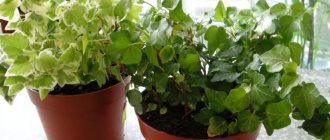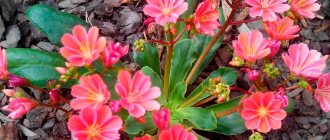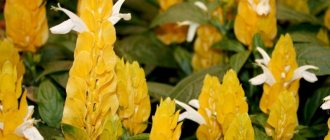Strelitzias are evergreen, herbaceous perennials with unusual flowers and equally exotic leaves, which in their natural environment can reach ten meters in height.
The way the flower is formed and the way Strelitzia is pollinated deserves special attention. The shell from which the “paradise” flower is born is positioned horizontally relative to the surface before flowering and has the shape of a bird’s “beak”. This shell has its own name - “spathe”, which translates as “wrapper”, and can have a length, depending on the type of sterlitium, up to half a meter. The flowers emerge directly from the involucre and have a number of petals, with several joining together in an arrow-shaped shape to form a "nectary". At the moment when a bird, attracted by nectar, lands on a flower, the petals open, throwing pollen onto it, which the bird transfers to other plants.
These green inhabitants of the African continent became known to Europeans at the end of the 18th century thanks to the Scottish naturalist Francis Masson. The name of the genus is given in honor of the English queen. The genus has five species, which are described in detail below. In addition to the main species, there are many hybrids.
Description of Strelitzia
The amazingly beautiful flower was first discovered by the British who visited South Africa at the end of the 18th century. The plant captured their imagination so much that it was named after the king's wife Charlotte, née von Sterlitz.
Strelitzia grows in nature along river banks on sandy, fertile soil.
In the wild, this two-meter long perennial bush grows along the banks of drying streams and small rivers, among tall grasses and shrubs that shade it from the scorching sun. The soil in those places is fertile, but at the same time loose and sandy. Without its heavenly flowers, the plant is unremarkable.
The leaves are oblong-elliptical, up to 45 cm long and up to 20 cm wide, supported on a long petiole. The color of the leaves is dark green, the surface is leathery, veins are visible on the underside.
Strelitzia without its beautiful and unusual flowers looks decorative, but not bright
The most amazing part of the plant is the unusually shaped flowers. They appear only on mature plants and last up to several weeks. The inflorescence bud resembles a long straight beak located horizontally. The upper part of the “beak” gradually opens and flowers begin to appear from the petiole side. One such 15-centimeter bud contains 10-5 brightly colored flowers with an abundance of nectar. An adult plant can alternately produce up to 7 flower stalks, so flowering lasts up to six months, and when cut, the flowers will last in a vase for up to a month.
The Strelitzia flower resembles the head of a bird of paradise with a tuft.
Strelitzia has become a decoration for greenhouses, but is quite easy to care for and can be kept indoors. Its large size and long period of growth before abundant flowering make it truly exotic.
Designers love to add Strelitzia to bouquets and interior compositions.
Varieties
In nature, there are 5 types of Strelitzia, which differ in size: from two to 10 meters in height with leaves from 40 to 80 centimeters.
- Strelitzia reginae is nicknamed the crane by the local African people. It reaches a height of two meters, 2 times a year in spring and autumn it produces flower stalks with orange and blue flowers. Propagation is difficult, with sparse lateral shoots only from mature plants.
- Strelitzia reed is a hardy plant that can withstand extreme heat and drought, as well as temperature drops down to freezing. The flowers resemble Strelitzia regal in color, but differ in the shape of the leaves - they are needle-shaped. Distributed in eastern South Africa.
- Strelitzia montana is a tree up to 10 meters. Large leaves and white flowers. Not grown in indoor floriculture.
- Strelitzia Nicholas - was named in honor of the Russian Emperor Nicholas. Similar to the royal strelitzia, but reaches a height of 12 meters. Leaves are 80 cm wide and up to 200 cm long, flowers are white and blue.
- Strelitzia Augusta is also called white strelitzia. It has light green leaves and white flowers. It grows as a bush up to 1 meter in height, blooms from January to March, and is propagated by seeds and by dividing the bush. Often grown in greenhouses.
Photo gallery: Strelitzia varieties
Strelitzia reed with orange flowers and needle-like leaves
Strelitzia reginae is most often found in greenhouses, it has orange and blue petals, large, oval leaves
Strelitzia montana grows up to 10 meters in height, the flowers are white
Strelitzia Nicholas with white petals and blue-violet perianths
Strelitzia Augusta grows up to 1 meter, also called white Strelitzia
In open ground, Strelitzia can be seen not only in Africa; it is successfully grown on the Mediterranean coast, in Argentina, and even in the USA - in Los Angeles. In Russia and other countries with frosty winters, Strelitzia grows only in greenhouses or apartments.
In countries with warm winters, Strelitzia grows outdoors.
Features of Strelitzia
In natural conditions, Strelitzia is a herbaceous evergreen perennial plant. The height of the largest specimens in the wild can reach more than 10 m, and the average size of the bushes is 2–3.5 m. The core root system extends into the deep layers of the soil. The oval, large, leathery green leaf plates have a bluish-gray coating on the surface. The leaves can reach 0.1–0.8 m in width and 0.3–2 m in length; in appearance they are very similar to banana foliage, but their petioles are longer—0.5–0.9 m. On a long The peduncle contains a horizontal inflorescence, which is similar in appearance to the crest of a fancy bird; it consists of purple or orange flowers that reach 10–20 centimeters in diameter. There can be 5–7 flowers on one peduncle, while 6 peduncles and even more are formed on one bush; therefore, the plant can bloom for up to 6 months.
If you take good care of your home Strelitzia, it will delight you with its long, lush flowering several times a year. When cut, the flowers of this plant last a relatively long time - from 15 to 30 days.
Strelitzia Nikolai, history of the plant. Replanting in pots with automatic watering in the ground for Strelitzia
Conditions in the room
The plant is large, but rarely grows above 1.5 meters in a room. Decorative all year round.
Strelitzia can be grown in a large indoor florarium. But you will need to select plants that need dry, cool conditions in winter. In this case, the pot with the plant can simply be placed there.
To grow Strelitzia in a florarium you will need a lot of space, for example, a shower stall
Table: conditions of detention
| Parameter | Autumn winter | Spring Summer |
| Lighting | Bright light, direct sunlight, grows in partial shade | |
| Humidity | Regular room, should be wiped from dust | |
| Temperature | 14–15 degrees, but with additional lighting it grows at room temperature | Room temperature is suitable, it is advisable to take it out into the open air |
| Watering | When kept cool - scant | Abundant |
Brief description of cultivation
- Bloom . In spring for 6 weeks.
- Illumination . Diffused but bright light is needed, so it is best to choose an eastern or western window sill.
- Temperature regime . During intensive growth, the plant feels good at normal room temperature. In winter, the room should be colder than 14 degrees.
- Watering . During the growing season, it is necessary to water frequently, but moderately, and the soil mixture in the pot should always be slightly moist. In winter, watering is carried out approximately once every 1.5 weeks.
- Air humidity . It should be elevated. On hot days, moisten the foliage with a spray bottle.
- Fertilizer . During the growing season and during flowering, the bush is fed regularly once every 10 days, for this purpose mineral fertilizers and organic matter are alternately used.
- Quiet period . Conditional, in winter.
- Transplant . While the bush is young, it is replanted once a year, and older plants - once every 3 or 4 years.
- Reproduction . Seeds (must be freshly collected), side shoots and parts of those bushes that are already 6 or 7 years old.
- Harmful insects . Scale insects, mealybugs, aphids and spider mites.
- Diseases . This plant is highly resistant to disease. However, due to regular waterlogging of the soil mixture in the pot, the root system may rot.
Planting and transplanting
Strelitzia has large, fragile taproots, so you need to be careful when planting and replanting. Adult plants are replanted every 2–3 years, as needed.
Strelitzia prefers heavy loamy nutrient soil. For preparation, take leaf soil, turf soil, compost, humus and a little sand. Add 1 part sand to 2 parts soil and 2 parts compost and humus.
Due to the characteristics of the root system, it is advisable to take a high pot. Unlike other plants, Strelitzia blooms faster in a spacious flowerpot or tub.
Strelitzia will not grow well in such a small pot
Since the roots of the plant are fragile, it is better to use transshipment instead of replanting, especially for young plants. If the Strelitzia is large, mature and has lateral shoots, then combine the replanting with propagation - dividing the bush.
Procedure:
- We choose a suitable pot, larger than the previous one.
- At the bottom we lay a layer of expanded clay drainage, up to 4–5 cm thick. Then pour a handful of fresh soil.
- Turn the pot over and take out the Strelitzia, holding it between your fingers and holding the soil with your palm.
- Place the plant in a new pot and sprinkle the side with soil. Water lightly.
Video: transshipment of Strelitzia
About transplantation after purchase
Strelitzia sold in stores is often grown from seeds in warm countries, and brought in a shipping pot and soil, so replant such a plant immediately. In this case, the “bird of paradise” is not pulled out of the pot, but the pot is cut with scissors. Use caution if plant roots emerge from drainage holes. If the root still breaks off, then sprinkle the wound with crushed activated carbon and let it dry. Further actions are the same as when transshipping a plant.
Strelitzia roots are large, fleshy and very fragile
As a rule, a correctly planted plant holds its shape well, the leaves grow upward and the bush does not fall apart, remaining compact and not needing support.
Reproduction
Strelitzia can be propagated using seeds, dividing the bush into parts and separating the side shoots from the mother bush. Let's consider all the methods:
Propagation by seeds
Growing Strelitzia from seeds is the most preferable. Under natural conditions, Strelitzia seeds are formed after pollination of flowering plants by a tiny bird from the sunbird family. The height of the pollinating sunbird is less than 3 cm. The sweet nectar of Strelitzia attracts birds and pollinating insects to flowering plants. As soon as a sunbird or another bird lands on a flower and tries to get to the nectar, pollen from the stamens shoots around and settles on the breasts and legs of pollinators, which then transfer it from one flower to another. At home, you will play the role of a pollinating bird. To get your seeds, you must have several flowering Strelitzia bushes. If so, you can use a clean brush to gently transfer pollen from the stamens of one flower to the stamens of another. We recommend pollination several times during the week after the bud opens. If pollination is successful, the fruit (a woody, hard capsule) will ripen after six months. Freshly harvested Strelitzia seeds, cleared of pulp, should first be rubbed gently with sandpaper, then soaked for a day in hot (40 g) settled water, possibly with the addition of stimulants Epin or Zircon. Then the seeds are planted in a container with a damp mixture of peat and sand under a lid, to a depth of half a centimeter. Seeds germinate within one to two months (sometimes longer) in a bright place at a temperature of 22 - 24 degrees. The greenhouse is ventilated and watered abundantly. When the sprouts are ready for transplantation, that is, the first leaves appear, they are transplanted into separate pots of suitable size according to all the rules of transplantation with nutritious soil and drainage and placed in a cooler place. Do not forget that the roots are very fragile and can be easily damaged. Therefore, replant very carefully. Damaged roots in childhood can affect the entire subsequent life of the flower. If everything went well, an adult plant grown from seeds will bloom in three to four years, or even more. This is how lucky you are! The longest flowering is observed in Strelitzia at the age of 8 years. And the total period of its flowering is 10 years or more.
Reproduction by dividing the bush
It is performed less frequently, as there is a danger of ruining the entire bush. And only after the plant has finished flowering. This time falls at the end of winter and coincides with the moment of transplanting plants into new containers. The root system of Strelitzia, although powerful, is quite fragile; the roots are strongly intertwined. After roughly dividing the bush into parts, the plant may get sick and even die. If you managed to carefully divide the Strelitzia root system into parts, try to ensure that each part has two growth points. Otherwise, the transplanted bushes will grow poorly, take a long time to adapt, and their flowering will be delayed indefinitely. If the bush is successfully divided into parts, the new bushes will grow for at least another couple of years before they become mature, powerful and ready to flower.
Propagation by side shoots
Young, not yet flowering Strelitzia bushes can be divided without a problem if the bush itself has formed a side shoot. It is transplanted along with the roots into a new pot, and the mother plant is left in the same container. Sometimes, on the contrary, overgrown side shoots are used for propagation. They are carefully separated from the mother bush, if possible, along with the root, and planted in their own pots with drainage and nutrient soil under a film. The rooting process will be successful if the pot is placed on a bright windowsill and the temperature is maintained within 22 - 26 degrees.
This may be interesting: Oleander - rules for caring for a poisonous flower
Care
Despite the unusual flowering, Strelitzia does not require additional maintenance conditions.
Choosing a seat in the room
If the “bird of paradise” is grown not in greenhouses, but in an apartment, then it is better to provide the flower with a bright, bright place, with direct sunlight. But you can also place it a meter from the window. In summer, it is better to take the plant out onto the balcony or street. It is advisable to create differences in day and night temperatures even in the room.
Watering and fertilizing
You need to water abundantly and regularly only in the spring-summer season, slightly drying the top layer of soil, but it is important not to allow water to stagnate in the pot. In winter, when kept cool, Strelitzia is rarely watered. It is important to follow the watering regime for young plants so that the root system develops faster.
Recent Entries
5 working ways to use tar in the garden 7 indoor plants that help you get married even in adulthood Indoor plants that can bloom in trouble
Fertilizing is carried out 2 times a month with fertilizers for decorative flowering plants. It is better to use liquid fertilizers, combining them with watering. In winter, Strelitzia is not fertilized.
Liquid fertilizer for flowering plants is easy to use and very effective
Bird of paradise blooming
A plant grown from seeds blooms in 5–6 years, and propagated by root shoots in the third year. Abundant flowering occurs in adult 5-6 year old plants, and only under conditions of good lighting . If in winter Strelitzia has enough daylight hours, then it will produce flower stalks regularly, all year round.
It is very important to allow a strong root system to develop. So, a 1.5-meter plant needs to be planted in a pot with a diameter of more than 25 cm.
Blooming Strelitzia feels good in a deep pot
When flower stalks appear, they do not rearrange or move it. To stimulate adult Strelitzia to flower, provide it with cool, dry conditions for 2-3 months, this will promote the formation of flower buds. This period coincides with the beginning of autumn and the reduction in daylight hours. In February, the temperature is raised from 15 degrees to 22 and watered more often, and after 2 weeks the plant is fed.
Peduncles gradually appear, and buds also open: one after another, bright tufts flash above the green bush. In nature, Strelitzia is pollinated by sunbird butterflies, and the plant “shoots” pollen at birds that fly up to feast on nectar, sharply opening the anthers.
The Strelitzia flower attracts pollinators with its brightly colored petals and sweet nectar.
In the room, Strelitzia is pollinated if several plants bloom at the same time. Then the pollen is transferred from one flower to another. Once set, the germination rate is low; only 1 out of 10 seeds will produce a root .
Strelitzia seeds are quite large, located in a box that cracks after ripening
If the seeds do not set, then the peduncle is removed immediately when the petals dry.
Medinilla is also valued for its exotic flowering. You can learn how to provide her with decent care at home from the material:
Rest period
Typically, a period of rest occurs both in the wild and in apartments. Strelitzia, which grew on a balcony or on the street in the summer, needs a warm room, since already at a temperature of 10 degrees the delicate plant is damaged, and at zero degrees it dies.
Cool winter maintenance is useful for laying flower buds for the next flowering, so it is better to keep Strelitzia at 15–18 degrees Celsius with limited watering and no fertilizing. If it is not possible to lower the temperature to the required level, then provide Strelitzia with a long day by using illumination in the evening with phytolamps, LED or fluorescent.
Indoor species do not have a trunk, leaves grow from the ground, root shoots are formed rarely and only in mature plants, so there is no need for any actions to form a bush. You can cut off dry, old, yellow leaves.
Table: care errors
| Problem | Cause | Solution |
| Doesn't bloom |
|
|
| Drops buds | Moving the potty | It is not recommended to move the plant while the flower stalks are extending. |
| Slow growth |
|
|
| Black or brown spots on leaves, stem rotting | Watering with cold water, overwatering the plants | Strelitzia is sensitive to stagnation of moisture in the soil. If rot of the stems is detected, the plant is dug up, the roots are examined and the affected areas are cut out, sprinkled with crushed activated carbon. Then they are planted in fresh soil and watered rarely. |
Strelitzia care at home
Illumination
It is quite easy to grow Strelitzia at home, as it is distinguished by its unpretentiousness and low maintenance requirements. Since it grows best under bright, diffused lighting, it is recommended to place it on a western or eastern window. Do not allow the bush to be exposed to direct sunlight.
Temperature
This plant is heat-loving, but during the dormant period in winter it should be kept cool (no higher than 14 degrees). At other times of the year, it grows well and develops at temperatures typical for residential premises. In the warm season, if possible, it is recommended to move the Strelitzia outdoors (to the garden or to the balcony), but you should choose a place for it that will be reliably protected from gusts of wind and direct sunlight.
Watering
During the spring-summer period, watering should be moderate but frequent. Make sure that the soil mixture in the container is slightly moistened at all times. But do not overdo it with watering, as systematic stagnation of liquid in the root system can harm the plant. In winter, watering is carried out approximately once every 10 days. For irrigation, you should use filtered or well-settled water, the temperature of which is close to room temperature.
Air humidity
In indoor conditions, such a plant needs slightly increased air humidity. In this regard, on hot days, the leaf plates should be wiped with a damp sponge or sprayed with a spray bottle.
Top dressing
Domestic strelitzia is fed during flowering and during the growing season once every 1.5 weeks. For this purpose, both mineral fertilizers and organic matter are used, and they should be added to the substrate alternately. After flowering ends, the plant is not fed for 2–3 months, while there is a dormant period. Before moving the bush to a cool room where it can rest well, all its flower stalks are cut off.
Strelitzia transplant
If young bushes are replanted regularly once a year in the spring, this will have a positive effect on their development. Adult bushes undergo this procedure only once every 3 or 4 years, because their roots are very fragile and can easily break during transplantation.
However, some gardeners have learned to replant Strelitzia in such a way that its root system is not stressed. To do this, first prepare a special loose and nutritious soil mixture: combine sand, peat, humus, leaf and turf soil (taken in equal parts). The container for planting is taken high and a thick drainage layer is made at its bottom; it is sprinkled with a layer of prepared substrate. Then carefully transfer the healthy bush into a new pot and slowly fill all the voids with fresh soil mixture, which is compacted regularly. If the bush has problems with roots, then first remove it from the old pot and carefully remove all the old substrate. After this, carefully inspect the root system and cut out all diseased areas, and then sprinkle the cut areas with charcoal powder. Next, the bush is planted in a new container.
Transplantation











